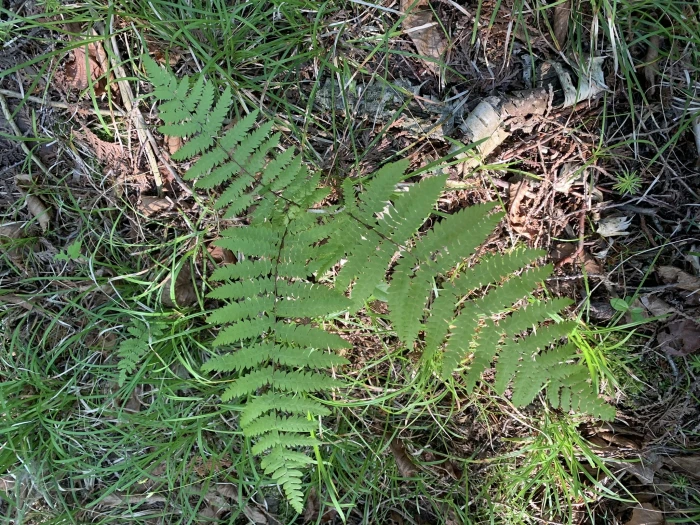Eastern Marsh Fern
(Thelypteris palustris subsp. pubescens)
Eastern Marsh Fern (Thelypteris palustris subsp. pubescens)
/
/

Paul Prior
CC BY 4.0
Image By:
Paul Prior
Recorded By:
Copyright:
CC BY 4.0
Copyright Notice:
Photo by: Paul Prior | License Type: CC BY 4.0 | License URL: http://creativecommons.org/licenses/by/4.0/ | Rights Holder: Paul Prior | Publisher: iNaturalist | Date Created: 2020-06-30T08:54:39-07:00 |

















































Estimated Native Range
Climate Requirements for Layton, Utah
| This Plant | Your Site | Plant Suitability for Your Location | ||
|---|---|---|---|---|
| • Precipitation | 34" - 50" | 20" | Your precipitation may be insufficient for this plant. Irrigate N" / year. | Irrigate N" / year |
| • High Temp. | 77°F - 88°F | 90°F | Your summer temperatures are normal for this plant. | Excellent |
| • Low Temp. | -4°F - 24°F | 20°F | Your winter temperatures are normal for this plant | Excellent |
This plant should grow well at your location with about N inches per year (Y minutes per month) of irrigation.
Summary
Thelypteris palustris subsp. pubescens, commonly known as Eastern Marsh Fern, is a deciduous perennial herb that thrives in wetland habitats such as bogs, swamps, and marshy woodlands primarily in the Eastern United States. It is also found in similar wetland habitats in Japan and Northern China. This fern typically reaches a height of 3 feet (0.9 meters) and a width of 2 feet (0.6 meters), featuring a clumping growth habit with multiple fronds emerging from a central point.
The Eastern Marsh Fern is appreciated for its lush green fronds that provide texture and interest in water garden settings and boggy areas. It is an excellent choice for naturalizing in wetland restoration projects or for use in rain gardens due to its high water requirement and tolerance for standing water. The fern prefers partial to full shade rather than full sun, which ensures the fronds remain vibrant and do not scorch. It is relatively low maintenance, requiring consistently moist to wet soil conditions and benefits from the addition of organic matter to the soil. While it does not produce showy flowers, its fronds contribute to the biodiversity of wetland ecosystems, offering habitat for various wildlife species. Gardeners should be aware that in ideal conditions, it can spread vigorously, potentially becoming aggressive in small garden spaces.CC BY-SA 4.0
The Eastern Marsh Fern is appreciated for its lush green fronds that provide texture and interest in water garden settings and boggy areas. It is an excellent choice for naturalizing in wetland restoration projects or for use in rain gardens due to its high water requirement and tolerance for standing water. The fern prefers partial to full shade rather than full sun, which ensures the fronds remain vibrant and do not scorch. It is relatively low maintenance, requiring consistently moist to wet soil conditions and benefits from the addition of organic matter to the soil. While it does not produce showy flowers, its fronds contribute to the biodiversity of wetland ecosystems, offering habitat for various wildlife species. Gardeners should be aware that in ideal conditions, it can spread vigorously, potentially becoming aggressive in small garden spaces.CC BY-SA 4.0
Plant Description
- Plant Type: Fern
- Height: 2.5-3 feet
- Width: 1.5-2 feet
- Growth Rate: Moderate
- Flower Color: N/A
- Flowering Season: Non-Flowering
- Leaf Retention: Deciduous
Growth Requirements
- Sun: Part Shade, Full Shade
- Water: High
- Drainage: Slow, Standing
Common Uses
Deer Resistant, Low Maintenance, Water Garden
Natural Habitat
Native to bogs, swamps, and marshy woodlands in the Eastern United States, Japan, and Northern China
Other Names
Common Names:
Scientific Names: Thelypteris palustris subsp. pubescens, Thelypteris palustris var. pubescens, Thelypteris palustris f. pubescens, Thelypteris thelypterioides, Thelypteris palustris var. haleana, Dryopteris thelypteris var. pubescens, Dryopteris tremula, Nephrodium thelypteris f. pufferae, Dryopteris thelypteris var. haleana
GBIF Accepted Name: Thelypteris palustris subsp. pubescens (G.Lawson) Fraser-Jenk.